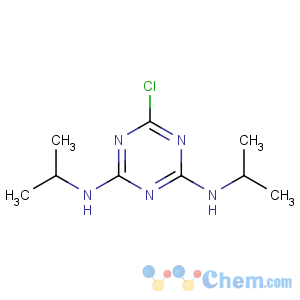Title: Propazine
CAS Registry Number: 139-40-2
CAS Name: 6-Chloro-
N,N¢-bis(1-methylethyl)-1,3,5-triazine-2,4-diamine
Synonyms: 2-chloro-4,6-bis(isopropylamino)-
s-triazine; 2,4-bis(isopropylamino)-6-chloro-
s-triazine
Manufacturers' Codes: G-30028
Trademarks: Prozinex (Makhteshim-Agan)
Molecular Formula: C9H16ClN5
Molecular Weight: 229.71
Percent Composition: C 47.06%, H 7.02%, Cl 15.43%, N 30.49%
Literature References: Selective pre-emergence herbicide. Prepn: Gysin, Knüsli,
CH 342784;
CH 342785 (both 1960 to Geigy). Toxicity study: G. W. Bailey, J. L. White,
Residue Rev. 10, 97 (1965).
Properties: Crystals, mp 213°. Solubility in water at 20° = 8.6 ppm; difficultly sol in organic solvents. LD50 orally in rats: >5000 mg/kg (Bailey, White).
Melting point: mp 213°
Toxicity data: LD50 orally in rats: >5000 mg/kg (Bailey, White)
Use: Herbicide.

